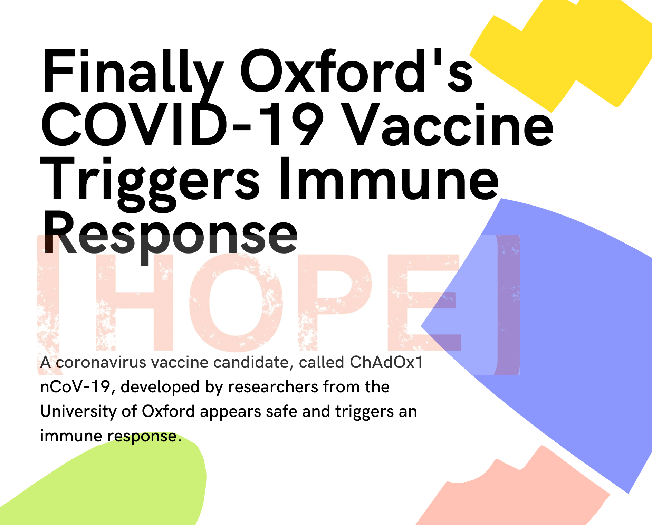Earlier in April 2020, researchers from the University of Oxford at the Oxford COVID-19 Vaccine Centre had initiated a clinical trial of their COVID-19 vaccine candidate- ChAdOx1 nCoV-19. Subsequently, they have already entered phase III of ChAdOx1 nCoV-19 after they successfully completed the phase I/II trial and published the result. The results are sure-fire especially when the whole world is severely waiting for curing methods of COVID-19.
1,077 volunteer participants, age between 18 and 55 years, were enrolled and assigned (between April 23 and May 21, 2020) for a single-blind and randomised controlled trial. Volunteers received either ChAdOx1 nCoV-19 or MenACWY. A total of 543 volunteers were assigned for the ChAdOx1 nCoV-19 trial and 534 for the MenACWY trial. In addition, 10 participants were assigned for non-randomised, unblinded ChAdOx1 nCoV-19 prime-boost group where they received two doses of the vaccine.
Assessing safety, reactogenicity, and immunogenicity from the trials, the team found no serious adverse health events related to ChAdOx1 nCoV-19 rather the injection led to them making antibodies and T-cells that can fight coronavirus.
Professor Andrew Pollard, Chief Investigator of the University of Oxford COVID-19 vaccine study said, “We saw the strongest immune response in the 10 participants who received two doses of the vaccine, indicating that this might be a good strategy for vaccination.”
The team has been working with the unprecedented urgency to develop a vaccine against currently ramping COVID-19 since January 2020 and now their results have imposed a new hope on the global population.
The vaccine candidate ChAdOx1 nCoV-19 resulted by the process of genetic engineering of the virus that causes common cold in chimpanzees. The common cold virus of chimpanzees was modified heavily so it will not show any adverse effects on person and also to make it look more like coronavirus- in the sense that vaccine resembles the coronavirus and the immune system can learn how to attack it.
This engineering was achieved basically by transferring the genetic instructions for the coronavirus's spike protein to the vaccine they were developing. Spike protein (S) is responsible for invading and affecting the host cell.
The University of Oxford is not alone on its COVID-19 vaccine journey. For its further development with searching for the possible loophole, large-scale manufacture, and potential distribution in the upcoming future of the Covid-19 vaccine, they are working with a UK-based global biopharmaceutical company called AstraZeneca.
Mene Pangalos, Executive Vice President of BioPharmaceuticals Research and Development at AstraZeneca said, “We are encouraged by the Phase I/II interim data showing AZD1222 was capable of generating a rapid antibody and T-cell response against SARS-CoV-2. While there is more work to be done, today’s data increases our confidence that the vaccine will work and allows us to continue our plans to manufacture the vaccine at scale for broad and equitable access around the world.”
Result showed that the used vaccine enraged and peaked a T cell ( a type of lymphocyte that plates a central role in the immune response) response within 14 days of vaccination and an anti-spike IgG (simply antibody) rose by day 28 indicating that antibodies are able to neutralise the virus so that it cannot infect cells.
Oxford and AstraZeneca are also collaborating with clinical partners around the globe. They are working under a part of a global clinical program, including the USA where 30,000 patients are projected to enroll in its phase III study, as well as a paediatric study and also in low-to-middle income countries including Brazil and South Africa which are already underway.
There seem to have no major side effects of ChAdOx1 nCoV-19, however, 70% of people on the trial developed either fever or headache which paves a little bit of hindrance but researchers say this could be managed with paracetamol.
"There is still much work to be done before we can confirm if our vaccine will help manage the Covid-19 pandemic, but these early results hold promise,” says Prof Sarah Gilbert, from the University of Oxford, UK.
So far the vaccine candidate is safe and sound but their main purpose is to ensure the vaccine is safe enough to give to people and they are even doing more trials in the next stage. For the more elaborate and confirmed study, they have already initiated its next phase enrollment of the volunteers where 30,000 people will be from the USA, 2,000 in South Africa, and 5,000 from Brazil. Let’s hope the result will come in the favour of global needs and requirements.
Though the UK has already ordered 100 million doses of the vaccine, Boris Johnson said, "Obviously I'm hopeful, I've got my fingers crossed, but to say I'm 100% confident we'll get a vaccine this year, or indeed next year, is, alas, just an exaggeration. We are not there yet.”
The study is ongoing and was registered at ISRCTN, 15281137, and ClinicalTrials.gov, NCT04324606.
“The UK is fortunate to have such outstanding academic innovators working alongside the highly experienced global team at AstraZeneca. This partnership is working at exceptional speed to demonstrate the safety and clinical effectiveness of the chadox vaccine in protecting people against COVID-19 infection”, says Kate Bingham, Chair of the UK's Vaccine Taskforce
The finding from its phase I/II was published in the journal The Lancet on July 20, 2020. Hope this will work and the global health market will get access to the COVID-19 vaccine, thought it become late, in the near future.
You can download and see more about the COVID-19 vaccine candidate around the globe with their recently updated status (phase) at WHO.
